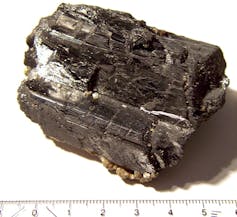High levels of tungsten, a metal found in mobile phones and a variety of industrial uses, could double the risk of stroke according to researchers from Exeter University who believe exposure to tungsten could also be a significant risk factor for stroke in the under-50s.
Using data from the US National Health and Nutrition Examination Survey, the Exeter team analysed information on more than 8,000 participants aged between 18 and 74 collected over a 12-year period from 1999 to 2010. In one of the most comprehensive analyses of the health risks of tungsten, they found that higher tungsten levels in urine samples were strongly associated with an increase in the prevalence of stroke.

Tungsten, also known as wolfram, is a hard, rare metal that has the highest melting point of any pure metal, although it has to be extracted from other minerals such as wolframite and scheelite.
Its strength and durability have made it valuable for a variety of uses including light bulb filaments, X-ray tubes, bullets (to replace more “dangerous” lead ones) and in consumer products such as mobile phones and computers.
Jessica Tyrrell, co-author of the study, said: “We are exposed to tungsten from a range of sources, the air we breathe, the water we drink, the food we eat (tungsten is in soil), however all tend to be low-level exposures. Given the increased use of the metal, it’s likely that there will be more tungsten in the environment in the future which will increase our exposure risk.”
While the study, published in PLOS ONE, showed an association between high levels of tungsten and stroke risk, it doesn’t explain why tungsten was higher in some people more than others. Higher tungsten levels are also a relative measure, said Tyrrell, because so little is known about our exposure, unlike other metals such as lead or mercury. Instead the researchers considered a one-unit increase in tungsten concentration as higher risk.
“We know very little about human exposure levels, except that it tends to be low in the ug/ml region,” she said. “Individuals who work occupationally with the metal have higher levels of the metal. We didn’t look specifically at the demographics and lifestyle factors that constituted high tungsten levels but this will be part of our future research.”
Low exposure but little knowledge

On the whole, our exposure to tungsten is thought to be low. However, an increase in demand for electronic gadgets and wide industrial applications such as welding, as well as more unusual ones – for the 2012 Mars Science Laboratory space probe or in making darts, for example – have increased concerns about its toxicology.
The US Environmental Protection Agency and the US Department of Defense, for example, consider tungsten a growing concern. While it was originally considered a metal that was stable in soil and relatively insoluble in water, studies have suggested that in some forms, the metal can move through soil and get into groundwater.
In 2002, the US Centers for Disease Control investigated a number of leukaemia clusters in the western US and found tungsten in urine samples that were significantly higher than national comparisons. However, an association between the cancers and tungsten couldn’t be made.
New and nano technologies
Susan Hodgson, a lecturer in Environmental Epidemiology and Exposure at Imperial College, London, said tungsten’s use in new technologies meant we should know more about the potential risk.
“There has been considerable research on the health impacts of more established toxic heavy metals, such as cadmium, mercury and lead, which even at low levels of exposure have been shown to be associated with hypertension and cardiovascular disease, bone mineral density and osteoporosis and kidney damage, all leading causes of morbidity and mortality in the UK and elsewhere,” Hodgson said.
“There is growing interest in emerging metal contaminants, due to their use in new technologies (for example rare earth elements in catalysts, semiconductors, fuel cells), but little is known about their health impacts, alone or as mixed exposures. This study is valuable in providing information on the levels of general population exposure to tungsten and provides both a baseline against which to assess changes in exposure over time, as well as an indication of the adverse human health impacts tungsten exposure might confer.”
Nicholas Osborne, another co-author on the study, said the link between tungsten and stroke could be the “tip of the iceberg” amid a rise in the production of chemicals for commercial uses such as nanotechnology. “As numerous new substances make their way into the environment, we’re accumulating a complex ‘chemical cocktail’ in our bodies,” he said. “Currently, we have incredibly limited information on the health effects of individual chemicals and no research has explored how these compounds might interact together to impact human health.”
Saugata Datta, a chemical hydrogeologist from Kansas State University, said soil acidity played a part in how tungsten could enter a water source: “The mobility of tungsten from soils or sediments to groundwater or drinking water isn’t very well understood. But natural sediments and rocks have background levels (low levels) of W [tungsten’s chemical symbol], in them,” he said.
“But when groundwater comes into contact with the sediments under certain pH and changes in oxidiation, this releases the W from the mineral structures and mobilises it in the environment (in the subsurface aquifers where drinking water exists). This natural process is exacerbated by human additions including the W used in bullets, or W-mineral smelting plants.”

